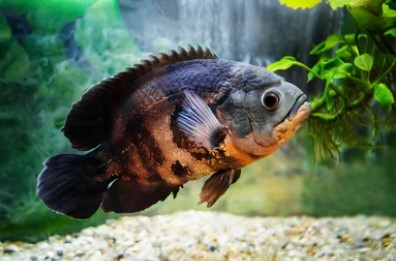Cichlids is the collective name for fish in the family Cichlidae, with about 200 genera and over 2,000 species known, making it a large family of scleractinian fishes. Cichlids are mainly freshwater fish found in tropical America, continental Africa, Madagascar, and South Asia. Most species are African and show great diversity in the central African lakes.
 Figure 1. The bright Oscar fish is a South American freshwater fish from the cichlid family.
Figure 1. The bright Oscar fish is a South American freshwater fish from the cichlid family.
Many cichlids, especially tilapia, are important food fish. At the same time, cichlids have ornamental value, and many species in this family are favored by aquariums or hobbyists, such as oscar (Astronotus ocellatus), convict cichlid (Archocentrus nigrofasciatus), and discus fish (Symphysodon).
With the development of biotechnology and sequencing and resolution of the cichlid genome, gene editing technology has been applied to cichlids. As a fish biotechnology expert, Lifeasible provides cichlid gene editing technology services. Our existing cichlid gene editing technology service platform can help you explore gene function, improve genetic breeding, etc.
Usually, gene function is directly explored in a limited number of model organisms. However, the CRISPR/Cas system is a species-independent technology capable of editing and manipulating genes in multiple models to help scientists gain insight into fish evolution and development. We chose Astatotilapia burtoni, a cichlid fish that has been extensively studied in the laboratory and is present in Lake Tanganyika and its surrounding waterways, as a model for behavioral and neurobiological studies to develop a cichlid CRISPR editing system.
The tyrosinase (Tyr1) gene encodes a key enzyme for true melanin synthesis, and mutants lacking true melanin facilitate analysis of neural signaling. Therefore, we constructed LoF mutations in the Tyr1 gene using CRISPR/Cas9. First, we injected CRISPR gRNA and Cas9 into single-cell embryos using microinjection needles to induce mutations in the target genes. Astatotilapia burtoni progeny in which the target gene was inactivated by insertion were then screened by PCR. We propagate the mutant progeny for later analysis of the phenotype of interest.
 Figure 2. Overview of CRISPR/Cas9 mutagenesis workflow. (Li, C, et al. 2021)
Figure 2. Overview of CRISPR/Cas9 mutagenesis workflow. (Li, C, et al. 2021)
Lifeasible has created a CRISPR/Cas9 editing system for cichlids to help our clients in their fish-related genetic, breeding, and genetic research efforts. More importantly, our approach will facilitate the widespread application of CRISPR/Cas9 to studying cichlids and other non-traditional model aquatic species. For more information or any inquiry requirements, please contact us.
Reference
Lifeasible has established a one-stop service platform for plants. In addition to obtaining customized solutions for plant genetic engineering, customers can also conduct follow-up analysis and research on plants through our analysis platform. The analytical services we provide include but are not limited to the following:
Get Latest Lifeasible News and Updates Directly to Your Inbox